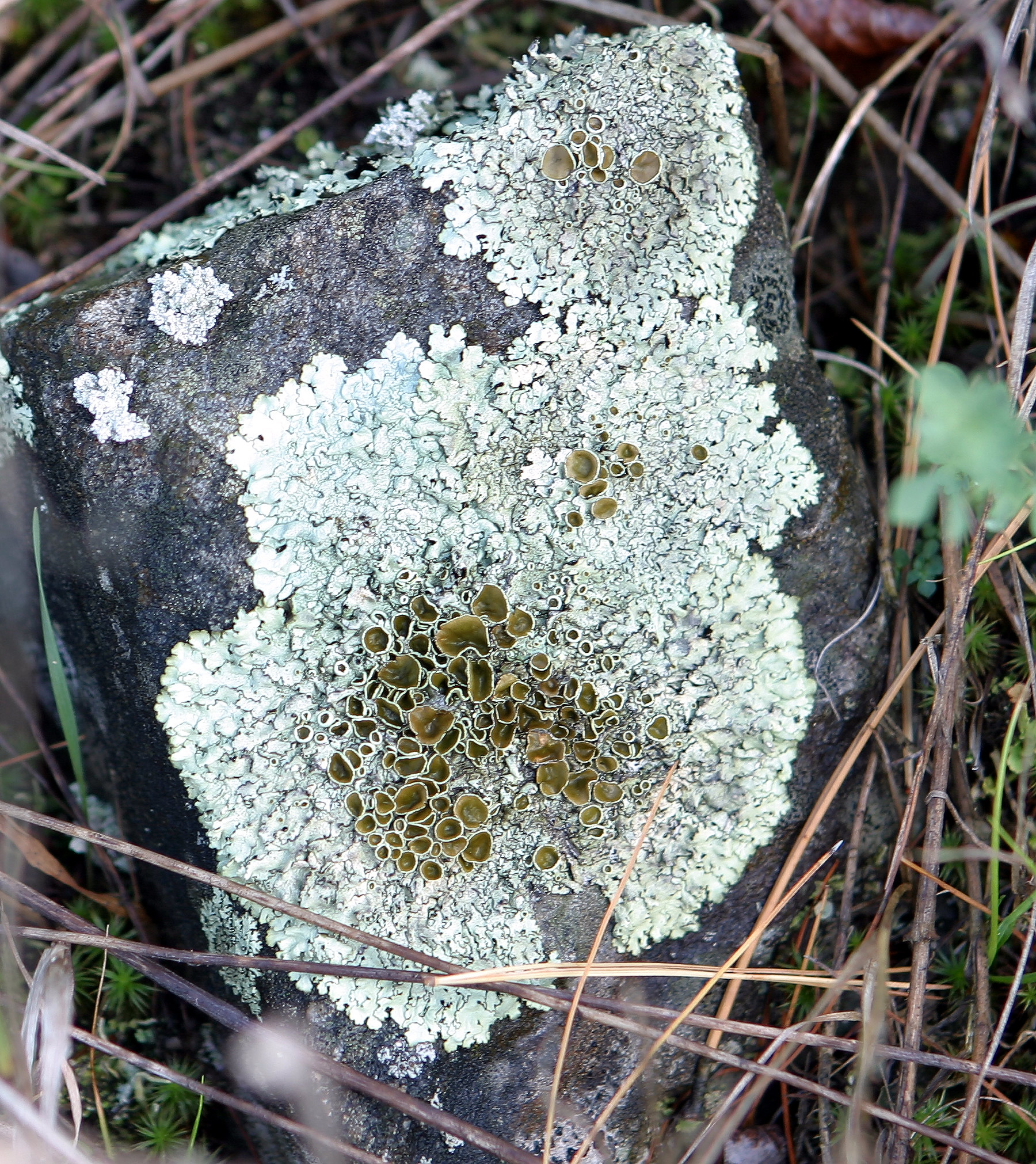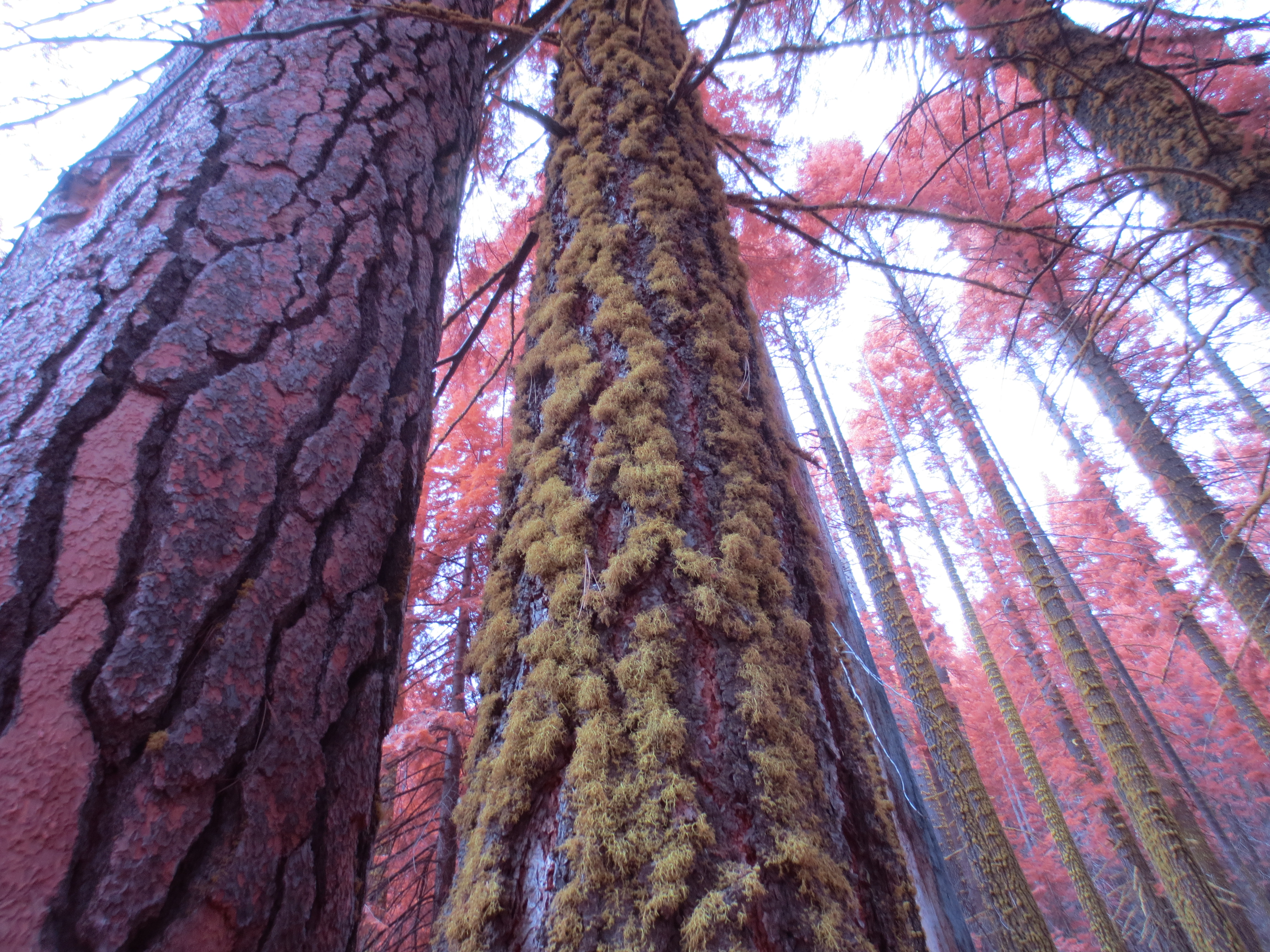|
Fruticose
A fruticose lichen is a form of lichen fungi that is characterized by a coral-like shrubby or bushy lichen growth forms, growth structure. It is formed from a symbiotic relationship of a photobiont such as green algae or less commonly cyanobacteria and one, two or more mycobionts. Fruticose lichens are not a monophyletic and holophyletic lineage, but are a form encountered in many classes. Fruticose lichens have a complex vegetation structure, and are characterized by an ascending, bushy or pendulous appearance. As with other lichens, many fruticose lichens can endure high degrees of desiccation. They grow slowly and often occur in habitats such as on tree barks, on rock surfaces and on soils in the Arctic and mountain regions. Characteristics Characteristic of fruticose lichen is the shape of the thallus. Like crustose lichen, fruticose lichen is composed of a holdfast which will act as an anchor for the lichen to grow in rock fissures, over loose sand or soil. Growth and struc ... [...More Info...] [...Related Items...] OR: [Wikipedia] [Google] [Baidu] |
Lichen Growth Forms
Lichens are symbiotic organisms made up of multiple species: a fungus, one or more photobionts (an alga and/or a cyanobacteria) and sometimes a yeast. They are regularly grouped by their external appearance – a characteristic known as their growth form. This form, which is based on the appearance of vegetative part of the lichen (its thallus), varies depending on the species and the environmental conditions it faces. Those who study lichens ( lichenologists) have described a dozen of these forms: areolate, byssoid, calicioid, cladoniform, crustose, filamentous, foliose, fruticose, gelatinous, leprose, placodioid and squamulose. Traditionally, crustose (flat), foliose (leafy) and fruticose (shrubby) are considered to be the three main forms. In addition to these more formalised, traditional growth types, there are a handful of informal types named for their resemblance to the lichens of specific genera. These include alectorioid, catapyrenioid, cetrarioid, hypogymnioid, parm ... [...More Info...] [...Related Items...] OR: [Wikipedia] [Google] [Baidu] |
Mycobiont
A lichen ( , ) is a hybrid colony of algae or cyanobacteria living symbiotically among filaments of multiple fungus species, along with yeasts and bacteria embedded in the cortex or "skin", in a mutualistic relationship.Introduction to Lichens – An Alliance between Kingdoms . University of California Museum of Paleontology. . Lichens are the lifeform that first brought the term symbiosis (as ''Symbiotismus'') into biological context. Lichens have since been recognized as important actors in and producers which many higher trophic feeders feed on, such as reindeer, gastropods, nematodes, mites, and springtails. Lich ... [...More Info...] [...Related Items...] OR: [Wikipedia] [Google] [Baidu] |
Lichen
A lichen ( , ) is a hybrid colony (biology), colony of algae or cyanobacteria living symbiotically among hypha, filaments of multiple fungus species, along with yeasts and bacteria embedded in the cortex or "skin", in a mutualism (biology), mutualistic relationship.Introduction to Lichens – An Alliance between Kingdoms . University of California Museum of Paleontology. . Lichens are the lifeform that first brought the term symbiosis (as ''Symbiotismus'') into biological context. Lichens have since been recognized as important actors in nutrient cycling and producers which many higher trophic feeders feed on, such as reindeer, gastropods, nematodes, mites, and springtails. Lichens have properties different from those of their component organisms. They come in man ... [...More Info...] [...Related Items...] OR: [Wikipedia] [Google] [Baidu] |
Pertusariales
The Pertusariales are an order (biology), order of fungi in the class Lecanoromycetes, comprising 8 family (biology), families, 31 genera, and over 600 species, many of which form lichens. This diverse group is characterized by complex taxonomy (biology), taxonomic history and ongoing phylogenetic revisions. Originally proposed by Maurice Choisy in 1949 and later formally published by the lichenologists David L. Hawksworth and Ove Eriksson in 1986, Pertusariales has undergone significant reclassification due to molecular phylogenetics studies. The order includes well-known genera such as ''Pertusaria'' and ''Ochrolechia'', as well as families like Megasporaceae and Icmadophilaceae. Pertusariales species exhibit a wide range of morphology (biology), morphological features and ecological roles, from non-lichenized fungi to various forms of lichen symbioses. The order's taxonomy has been subject to considerable debate and revision, with recent research leading to the establishment o ... [...More Info...] [...Related Items...] OR: [Wikipedia] [Google] [Baidu] |
Letharia Vulpina JHollinger Crop
''Letharia'' is a genus of fruticose lichens belonging to the family Parmeliaceae. There were historically two species of ''Letharia'': '' L. vulpina'' and '' L. columbiana''. Recent molecular sequence studies published in 2016 confirm at least 6 species in Western North America alone, with more expected to be confirmed using similar methods in other parts of the world. The typical photobiont is a green alga of genus ''Trebouxia ''Trebouxia'' is a unicellular green alga. It is a photosynthetic organism that can exist in almost all habitats found in polar, tropical, and temperate regions.Erokhina, L. G., Shatilovich, A. V., Kaminskaya, O. P., & Gilichinskii, D. A. (2004 ...''. References Parmeliaceae Lecanorales genera Lichen genera Taxa named by Theodor Magnus Fries Taxa described in 1871 {{Parmeliaceae-stub ... [...More Info...] [...Related Items...] OR: [Wikipedia] [Google] [Baidu] |
Pseudephebe Minuscula
''Pseudephebe minuscula'' is a species of fruticose lichen in the family Parmeliaceae. In North America, it is known colloquially as coarse rockwool. It has an antitropical distribution. Description The lichen has a dark brown to almost black filamentous thallus, comprising individual cylindrical branches, closely attached to the rock substrate, often flattened, measuring 0.2–0.5 mm thick. It is common in windswept arctic and alpine environments, where it grows on granitic A granitoid is a broad term referring to a diverse group of coarse-grained igneous rocks that are widely distributed across the globe, covering a significant portion of the Earth's exposed surface and constituting a large part of the continental ... rocks and pebbles. References Parmeliaceae Lichens of Antarctica Lichens of Asia Lichens of Europe Lichens of Subarctic America Lichens described in 1878 Lichen species Taxa named by William Nylander (botanist) Taxa named by Ferdinand Christ ... [...More Info...] [...Related Items...] OR: [Wikipedia] [Google] [Baidu] |
Arthoniales
The Arthoniales is the second largest order of mainly crustose lichens, but fruticose lichens are present as well. The order contains around 1500 species, while the largest order with lichenized fungi, the Lecanorales, contains more than 14000 species. Classification The Arthoniales is one of two orders of the class Arthoniomycetes within the phylum Ascomycota. The order includes seven families ( Andreiomycetaceae, Arthoniaceae, Chrysotrichaceae, Lecanographaceae, Opegraphaceae, Roccellaceae and Roccellographaceae). Lecanographaceae, Roccellographaceae, Opegraphaceae and Roccellaceae are well-supported families within Arthoniales, and they were circumscribed in 2011. Andreiomycetaceae was described as a new family by Hodkinson and Lendemer in 2013. The Arthoniales is the sister group to Dothideomycetes. Figure 1. Cladogram of the Arthoniales, rooted with ''Curvularia brachyspora'', ''Cudonia circinans'' and ''Seynesia erumpens'' as the outgroup. The cladogram shows the ... [...More Info...] [...Related Items...] OR: [Wikipedia] [Google] [Baidu] |
Pseudephebe Pubescens
''Pseudephebe pubescens'', also known as 'fine rock wool', is a temperate alpine lichen. It is a member of the genus '' Pseudephebe'', a lichen group characterized by dense mats of brown to near-black "hairs". Taxonomy Linnaeus first described ''Lichen pubescens'' in 1753. Maurice Choisy transferred it to the genus '' Pseudephebe'' in 1930. It is usually distinguished from '' P. minuscula'' due to ''P. pubescens'' preferring a moister habitat, and its branches are more terete and lack the irregularities of ''P. minuscula.'' The morphological and ecological differences between the two species are often overlapping, and it can be difficult to truly distinguish the two without molecular analysis. Description ''Pseudephebe pubescens'' is a fruticose lichen that forms decumbent mats made of isotomic-dichotomous branching thalli. The branching occurs frequently and weaves around itself, leading to the woolen appearance. Dark brown to black in color and shiny. Apothecia are rare, but ... [...More Info...] [...Related Items...] OR: [Wikipedia] [Google] [Baidu] |
Peltigerales
Peltigerales is an order (biology), order of lichen-forming fungus, fungi belonging to the class (taxonomy), class Lecanoromycetes in the division (mycology), division Ascomycota. The taxonomy of the group has seen numerous changes; it was formerly often treated as a suborder of the order Lecanorales. It contains two suborders, eight family (biology), families and about 45 genus, genera such as ''Lobaria'' and ''Peltigera''. The fungi form lichens in a symbiosis, symbiotic relationship with one or two photosynthesis, photosynthetic partners which may be a cyanobacterium such as ''Nostoc'' or a green alga such as ''Coccomyxa''. The majority of species contain just a cyanobacterium, a smaller number have both a cyanobacterium and a green alga while only a few species have just a green alga. The thallus of the lichen may be foliose (leafy), subfruticose (somewhat shrubby) or granular-squamulose (scaly). The thallus attaches to a surface by means of small root-like rhizines. In some s ... [...More Info...] [...Related Items...] OR: [Wikipedia] [Google] [Baidu] |
Baeomycetales
The Baeomycetales are an order of mostly lichen-forming fungi in the subclass Ostropomycetidae, in the class Lecanoromycetes. It contains 8 families, 33 genera and about 170 species. As a result of molecular phylogenetics research published in the late 2010s, several orders were folded into the Baeomycetales, resulting in a substantial increase in the number of taxa. Taxonomy The family Baeomycetaceae was originally proposed by Barthélemy Charles Joseph Dumortier in 1829 (under the spelling ''Baeomyceae''); he included two genera, ''Baeomyces'' and ''Calicium''. Baeomycetaceae was initially classified in the Lecanorales, and Baeomycetaceae and Cladoniaceae were thought to be closely related, sharing a phylogenetic origin in Lecideaceae. It was transferred to the order Helotiales based on the structure of its ascus, which is similar to those in genus '' Leotia''. However, the Helotiales consists of mostly non-lichenised fungi. The first DNA studies conducted with ''Baeomyces' ... [...More Info...] [...Related Items...] OR: [Wikipedia] [Google] [Baidu] |





